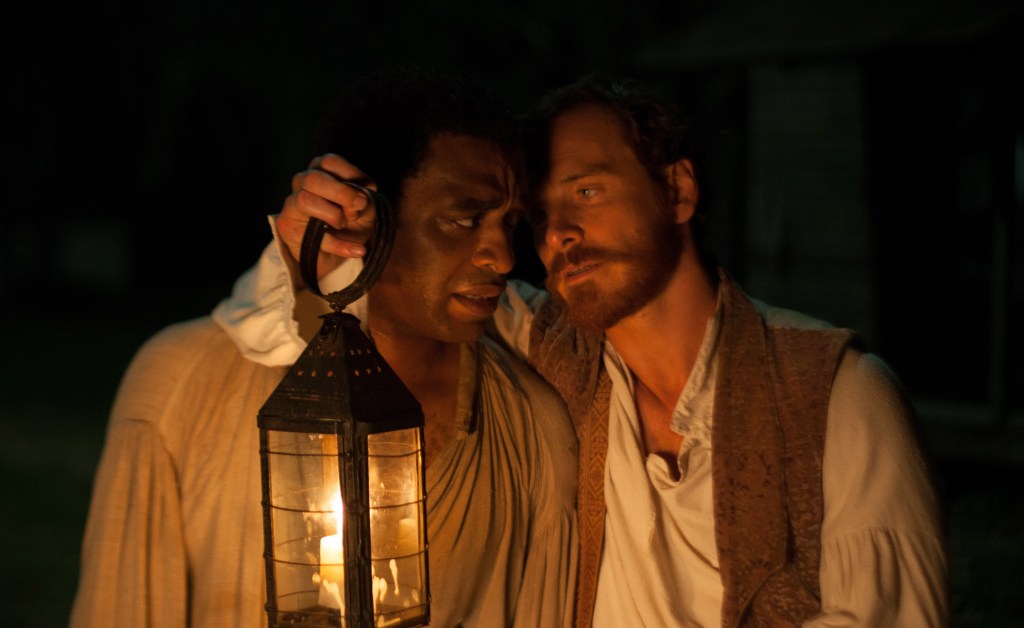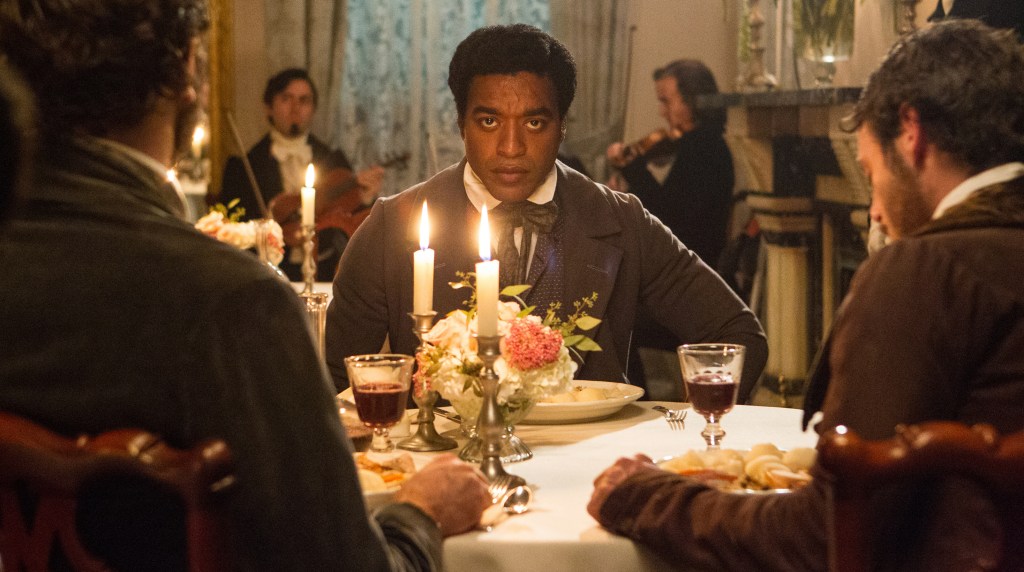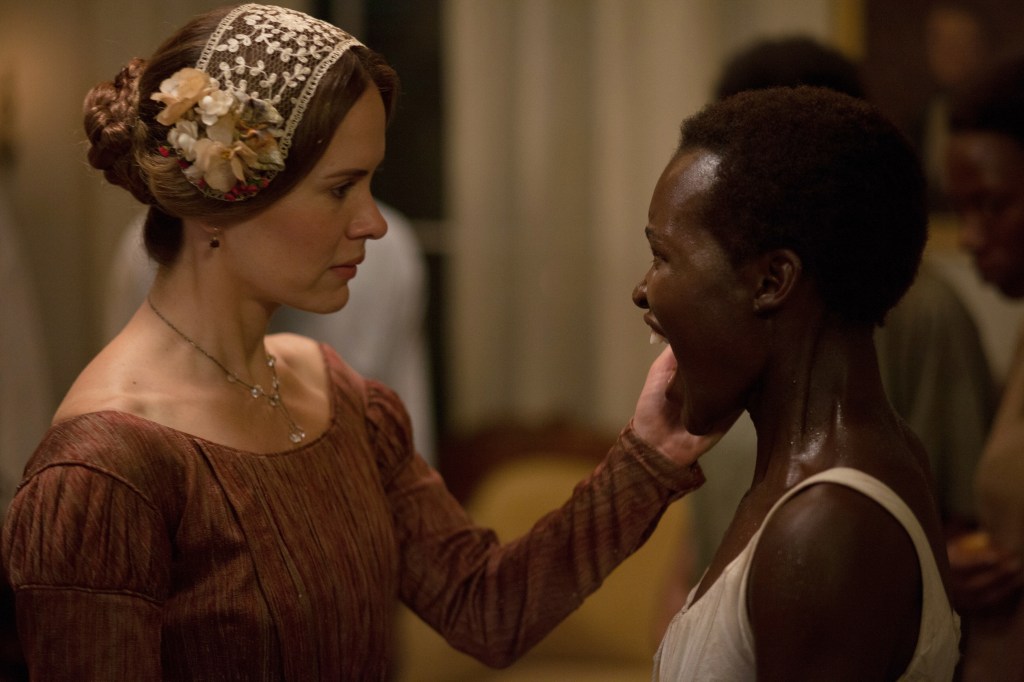At the start of “12 Years a Slave,” a nonfiction account of his experiences as a slave published in 1853, Solomon Northup expressed pleasure at the burgeoning number of books, newspaper articles and other writings that had started to sprout alongside his own memoir.
“Since my return to liberty, I have not failed to perceive the increasing interest throughout the Northern States, in regard to the subject of Slavery,” Northup wrote. “Works of fiction, professing to portray its features in their more pleasing as well as more repugnant aspects, have been circulated to an extent unprecedented, and, as I understand, have created a fruitful topic of comment and discussion.”
But 160 years later, movies remain reluctant to confront the subject. Aside from the seminal 1977 TV miniseries “Roots,” slavery has been relegated to background and subplots in the vast majority of filmed entertainments set during the early years of American history. “Amistad” took the true story of a savage mutiny aboard a ship transporting African slaves to America and turned it into a courtroom drama in which famous white actors argued about the definition of freedom. In most Civil War-era movies, black actors are either supporting players, doomed soldiers or victims waiting to be rescued. Quentin Tarantino’s “Django Unchained,” which spared no detail in its depiction of the brutality of slavery, kept its main protagonist on the sidelines for almost half the movie.
And even when the great Gordon Parks (“Shaft”) adapted Northup’s book for an episode of PBS’ “American Playhouse” in 1984, the memoir was condensed into a half hour special suitable for viewing in elementary school classrooms.
One of the most bracing things about “12 Years a Slave,” which opens locally this week, is the head-on approach director Steve McQueen and screenwriter John Ridley take to the material. There is no hand-holding, no comforting, no soothing musical score to heighten the sorrow and wring empathetic tears. The movie’s combination of clinical brusqueness and unexpected moments of dark, poetic beauty is unlike anything you’ve seen before. Solomon (played by Chiwetel Ejiofor) was a free man in Saratoga, N.Y., in 1841 with a wife and two children. He made a comfortable living as a musician. And then, over the course of a single night of too much wine, he wakes up in a dark, dank room, shackled and terrified and alone. “You ain’t a free man,” one of his captors tells him. “You’re a Georgia runaway.”
For the next 12 torturous years, Solomon will be stripped of his identity (Paul Giamatti plays a slave trader who renames him Platt), his dignity and, of course, his freedom. The film recounts Solomon’s experiences as he’s sold off like prized livestock to various plantation owners. None is more vicious or cruel than Epps (Michael Fassbender), a cotton farmer with a wife, Mary (Sarah Paulson), whose hateful stare reveals her sadism and disdain.
But one of the great things about “12 Years a Slave” is that the movie refuses to paint any of its characters in broad strokes: Rendering Epps and Mary as simply evil would undercut the film’s tremendous power. McQueen doesn’t want to make us suffer, because that’s easy to shrug off and leave behind at the theater. Instead, he wants to make us see and feel and try to understand.
“I had the idea of a free man who was kidnapped and brought into slavery,” the director says. “My wife (cultural critic Bianca Stigter) suggested Solomon’s book. I had never even heard of it. It was amazing – a biography of America, a first-hand account of what was going on then. It practically read like a script. And I liked the way the book explored slavery as an economic system. I didn’t want to portray slavery in black and white. It was immensely more complicated than that. Lines were blurred. It wasn’t as straightforward as we tend to think about it.”
A MORE ACCESSIBLE APPROACH
McQueen’s previous two films – 2008’s “Hunger,” about a prison hunger strike led by Bobby Sands, and 2011’s “Shame,” an NC-17 rated drama about sexual addiction – were too graphic and extreme for mainstream audiences. In “12 Years a Slave,” McQueen sets aside the rigorous style of those pictures for a more accessible narrative approach. He also shows surprising restraint with physical violence: Yes, there are scenes of whippings and torture that are difficult to watch. But the emotional and psychological violence in “12 Years a Slave” is arguably more disturbing, because the movie puts us inside the head of a man who has had everything taken away and must learn how to survive in this strange, dangerous new world.
Solomon’s refusal to give up hope – unlike some of his fellow slaves – anchors the film in a deep humanity. “I don’t want to survive,” he says. “I want to live.” Although the audience knows Solomon will live long enough to be freed and reunited with his family, he believes he could be killed at any moment for the slightest transgression. Early in the film, when he rises up against a farmhand (Paul Dano) who torments him one time too many, the moment is incredibly cathartic – finally, a chance to fight back – but it also fills you with dread, because you know Solomon will be gravely punished for what he has done.
“The slaves knew what would happen to them if they rebelled, but sometimes they couldn’t help themselves,” McQueen says. “There was a huge slave revolt in Louisiana in 1811, before Solomon got there. They took arms against their plantation owner and killed his son. Eventually, more than 100 slaves were killed. They were caught and tortured and decapitated. Every head was put on a pole and placed outside each of the slave shacks as a kind of warning. The constant threat of fear and reprisal was a part of their everyday lives.”
That emotional head space was something that took awhile for Ejiofor to inhabit, because the extremity of it has no counterpart in his everyday life.
“When I read the script, I was stunned by it, because it told the story from inside the character’s head,” the actor says. “It took me a moment to get my head around it and dive in. But as soon as I committed to the project and stepped in front of the camera, I started to understand Solomon and how he thought. I felt something profound. It became a privilege to go on that journey, to get down to Louisiana and those plantations and out in those fields and recreate what actually happened there. I stopped thinking about the camera at all. I was living moment to moment, like Solomon did. I felt like I had scurried down this rabbit hole and was stuck in the darkest of fairy tales.”
Just as remarkable as Ejiofor’s performance is the portrayal by Fassbender of the maniacal Epps, a monster far more complex than anything the Grimm Brothers ever dreamed up.
“Epps is psychotic, for sure, but there are various elements to his sickness,” says Fassbender, who previously worked with McQueen on “Hunger” and “Shame.” “He’s a plantation owner obsessed with being on top of it all, so there isn’t a day that goes by where the slaves are working on the field and he isn’t watching them. On the one day of the week when they’re off, he can’t be without them. He goes into the slave quarters and drags them into the main house to play music and dance with them. He has a dependency on them that goes beyond economics: He has an emotional connection with them, too.
“His relationship with Solomon is more complicated. He’s threatened by Solomon, even though he can’t put his finger on it. He suspects Solomon is a much higher intellect than him, so he tries to destroy Patsey (Lupita Nyong’o), a young slave Solomon has befriended. That is Epps’ way of trying to get over his insecurities. But he only ends up intensifying it.”
HOPE FOR HUMANITY
Fassbender credits McQueen for populating “12 Years a Slave” with characters both big and small that are all fully realized (Alfre Woodard appears in one scene as a slave who has learned to work the system to her advantage, and her performance is so strong, she merits her own movie).
“Steve has such a good understanding of the human condition,” Fassbender says. “He has great hope in it and a great fear of the reality of it. When you walk onto his set, there’s no time for (B.S.) or hanging out or playing games. It’s time to search for the truth of how frail we are as human beings. And he never judges any of his characters, good or evil. He loved the idea that (Solomon) could retain his sense of love even after this incredible ordeal. When he is reunited with his family, the first thing he says to them is ‘Forgive me.’ That line is crushing, because you see the dignity and integrity of this man.”
Edmund Abaka, Ph.D, an associate professor of history at the University of Miami, says the release of “12 Years a Slave” may be the instigator for a cultural conversation about a chapter in history that is still not yet fully explored in high-school history classes, because it is too unpleasant and ugly, and it’s too shameful to remember that this was once the face of America.
“That sentiment is still alive and well,” Abaka says. “It happened so long ago. Now we have a black president. Why should we even worry about that? Let’s get over it! But the slavery era is deeply woven into the fabric of the African-American experience. The resilience of the people who survived and resisted and forged new identities and cultures and music is extraordinary. The violence is one side of it. But another side is the complexity of the individuals. Some slaves killed themselves so they didn’t have to suffer. Some struggled through it to provide for their families. Fathers did whatever they could do to protect their children. That complexity is often lost when you focus too much on the horror and the brutality. People persevered with their lives despite these incredible challenges and, in the long run, they thrived.”
The lack of a neat resolution in “12 Years a Slave” – no resounding triumph over villains – gives the film a haunting power that connects it to the present day. And out of all of the film’s striking shots, none may be more powerful than a long, wordless take of Solomon standing in the woods, looking around and listening to the sounds of nature, the expression on his face conveying the emotional and physical toll of his experiences. And then he looks directly into the camera, addressing the viewer with an uncommon intimacy.
“Sometimes dialogue isn’t necessary,” McQueen says. “Often, you can say a lot more in one shot than you can say in seven shots. It’s a combination of the economics of filmmaking – we shot this movie in 35 days – and of thinking in visual terms. In that scene, Ejiofor expresses so much without saying a word. The hope is that you take that home with you and think about it.”
Copy the Story LinkSend questions/comments to the editors.





Success. Please wait for the page to reload. If the page does not reload within 5 seconds, please refresh the page.
Enter your email and password to access comments.
Hi, to comment on stories you must . This profile is in addition to your subscription and website login.
Already have a commenting profile? .
Invalid username/password.
Please check your email to confirm and complete your registration.
Only subscribers are eligible to post comments. Please subscribe or login first for digital access. Here’s why.
Use the form below to reset your password. When you've submitted your account email, we will send an email with a reset code.